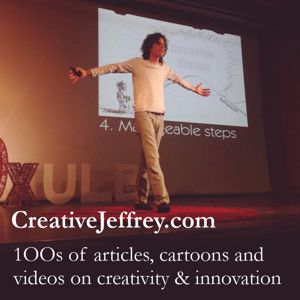Report 103
Your newsletter on applied creativity, imagination, ideas and innovation in business.
Tuesday, 16 January 2007
Issue 98
Hello and welcome to another issue of Report 103, your fortnightly newsletter on creativity, imagination, ideas and innovation in business.
As always, if you have news about creativity, imagination, ideas, or innovation please feel free to forward it to me for potential inclusion in Report103. Your comments and feedback are also always welcome.
Information on unsubscribing, archives, reprinting articles, etc can be found at the end of this newsletter.
IMAGINATION, CREATIVITY, IDEAS AND INNOVATION
With 90% of senior managers claiming innovation is critical to their companies and every big consultancy now offering innovation consultancy services, the word “innovation” has become one of the sexiest business terms in recent years. Sadly, it also frequently misused. This is important. In order to analyse why innovation initiatives work or don't work (and far too many of them are still not working), it helps to understand properly the word “innovation” as well as the related words: “creativity”, “ideas” and “imagination” and how they all fit into the innovation process.
- Imagination is the fertile field of your mind where ideas are born.
- Creativity is the act of creation and development of ideas.
- Ideas represent two or more bits of information, thoughts or opinions brought together in your imagination in order to create a new concept.
- Innovation is the implementation of creative ideas. In the business context, innovation usually implies not only the implementation of creative ideas, but also profiting from their implementation.
Let's look at each of these concepts in more detail.
Just as some fields are more fertile than others, so too are some imaginations more fertile than others. Moreover, as any farmer knows, planting the same crop in the same field year after year is a sure way to make the field less fertile, and that results in plants that are like the plants from previous years – but not so nice. Likewise, when the mind is subject to routine thinking day in and day out for years, its imagination becomes less fertile and ideas are often poor copies of past ideas. Employees working in repetitive jobs without change are much the same. They lose their imaginative capabilities and so cannot produce such lush ideas as minds which are challenged by new ideas, activities, responsibilities and – of course - challenges.
Creativity is the process of generating ideas. The creative thinker might look at fields of vegetables and dream up vegetarian foods she could make with those vegetables: pasta sauces, curries, salads and the like. She might even dream up exotic new recipes that no one has ever thought up before.
And the creative ideas she generates come from combining her understanding of the various vegetables, their tastes and other foods she has eaten. Each piece of knowledge or opinion already exists in her mind. By themselves, they do not represent creative ideas. But combined together in new ways to create new foods, they become parts of creative ideas.
As long as we are only thinking about new food ideas, we are being creative. When we actually make those foods, then we are being innovative. And when we sell those foods and make a profit – we are being innovative in the business sense of the term.
The distinction between creativity and innovation is critical – yet it is often blurred. Many times, when people talk about innovation, they really mean creativity. Worse, many of us who know better use the term “innovation” when we really know we are talking about creativity. We do this to simplify explanations or to impress clients who want to be more innovative. I am ashamed to confess I have even done this myself on one or two occasions. But I shall henceforth do better!
Likewise, many senior managers don't know the difference between creativity and innovation. Indeed, there is a tendency in business to see creativity as being something advertising people and designers do; to see creativity as being an “arty-farty” thing with little relevance to innovation. But, of course, that is not true.
By not looking at the innovation process as one that includes imagination, ideas, creativity and innovation, the manager makes it difficult to analyse their innovation process in order to determine where weaknesses lie.
If employees' imaginations are not fertile, that is if they are not stimulated to think creatively, then they will not generate such good ideas as they are capable of. This is an issue in many firms where a highly structured corporate environment focusing on zero mistakes is also a highly stifling environment – at least as far as employees' imaginations are concerned.
On the other hand, a corporate environment that involves regular challenges and new inputs can be highly stimulating to the imagination. Employees who get away from their desks and work with clients or in the field are often even more stimulated than those who stay in the office all day.
If employees' imaginations are stimulated, but innovation is not happening, it may be that their ideas are not being harvested. Consider our fertile field analogy for the imagination. Have you ever seen a corn field, or a field of any crop, left untouched past the harvesting season? The vegetables rot, the plants dry up and everything decomposes back into the fields.
This happens in many firms in the developed world today. Employees are given a certain amount of freedom and responsibility to accomplish their tasks. And this stimulates their imaginations. However, when an employee has a creative new idea, it is difficult for her to communicate the idea to a senior manager who is able to implement the idea. At the same time, the firm has no idea management tool or other process to harvest ideas. So the employee's idea and all of her colleagues' ideas, like the corn left in the field, rots.
Some firms, however, have implemented tools to harvest ideas. These tools include idea management systems (like Jenni – http://www.creativejeffrey.com/jenni/), brainstorming, ideation events, suggestion schemes and so on. Furthermore, employees develop their ideas into business plans, they make PowerPoint presentations to senior managers, they make prototypes and more. But, in the end, management decides the idea is too risky and decides to stick with business as usual rather than chance a radical new idea.
In the last case, the flaw is in the innovation process itself. Such firms have employees with fertile imaginations, creativity, idea harvesting tools and a stated desire to innovate. Nevertheless, they do not.
It is worth noting that the further you progress in innovation, the more expensive failure becomes. Stimulating imaginations, encouraging creativity, providing idea harvesting tools, reviewing ideas and testing ideas all cost money. If you do not intend to implement the most creative – and potentially most innovative ideas at the end of the process, you are wasting a considerable sum.
On the other hand, if you have all the will in the world to be more innovative, but do not provide your employees with the variety, change and freedom their imaginations need, their imaginations will not produce the creative ideas you need in order to innovate.
So, if your innovation process is not generating the results you expect, the first thing to do is to determine whether the problem really is with innovation; or if it is with creativity or imagination or a combination therein.
Then act upon it!
PS: It is worth bearing in mind that in this article I have been looking at imagination, ideas, creativity and innovation from a business perspective. Innovation, in particular, has a somewhat different meaning in the arts. An innovative artist will take a medium to a new level; while a creative artist will be creative within the rules of an existing medium. Thus Paul Cézanne and Pablo Picasso can be considered innovative painters for their development of Cubism as an art form. The many other early 20th century painters who explored cubism may have been creative, indeed they may have been highly creative. But they would not be considered innovative – unless they take a medium to a new level.
DON'T PANIC, ASK THE RIGHT QUESTION
When a person is under pressure and needs ideas quickly, she all too often asks herself the wrong question. And when time is of the essence, asking the wrong question can be a critical waste of time. That wrong question is almost always: “what am I going to do?” or possibly, “What are we going to do?”
I am reminded of a sales meeting I sat in on some years ago. At the time I was offering e-business consulting services to this firm and helping their sales people devise potential 'products' to offer clients. In this meeting, the general manager scolded the sales people for poor results and said that if sales did not increase by a specific amount, heads would roll. (This general manager was not particularly good at positive motivation, as you can see).
Upon leaving the meeting, the senior sales manager was audibly asking himself “What are we going to do?”
This is a typical reaction to being forced to come up with ideas in a stressful situation. But, asking, “What am I going to do?” or “What are we going to do?” invokes a sense of panic and desperate thinking. Initial ideas often include: leave the company, complain to senior management, get stinking drunk and so on. They are not very productive ideas. That's because the question was all wrong.
I do not condone the general manager's approach to dealing with poor sales at all. And, from what I hear, Employees are demotivated and the company continues to perform poorly in Europe.
Sadly, in the real world, we have to deal with superiors, clients and others who are less than motivational. It is understandable that the sales manager's first reaction was “What are we going to do?”. However, his next question should have been “In what ways might we improve sales?”
If he had had time, he might first have asked “why are sales poor?” But often in such situations there is not sufficient time to analyse problems. Moreover, a half-competent sales manager should know why sales are poor.
Sadly, the sales manager focused on panicking rather than problem solving and although the issue was not within my responsibility, I led the sales people in a discrete brainstorming session based on a better question, and helped them generate ideas to solve the problem.
This kind of thing happens all the time in business: “Your project is way over budget and running behind schedule. You've got until Friday to tell me how you are going to get back on track.” “If we don't come up with some good ideas for the Acme proposal, we'll lose the project to the competition.” “The print shop has just called, the workbooks for tomorrow's workshop cannot be printed on time.” and so on. Our reactions should not be: “What am I going to do?” rather they should be: “In what ways might I get my project back on schedule?”, “In what ways could we give the Acme proposal real impact?”, “How could we do the workshop effectively without the workbook?”
Finding answers in a crisis is never easy – even though we often like to think we more creative under pressure. But asking yourself the right question when you are under pressure is a big step towards finding the right creative solutions to urgent problems. Moreover, immediately generating ideas to solve problems impresses superiors, clients and business partners much more than asking yourself, “what am I going to do?”
OPTIMISM: AN ESSENTIAL INGREDIENT TO INNOVATION
One trait nearly all innovative people have in common is optimism. And that makes sense. If you are going to take a risk by implementing a creative idea which could fail spectacularly, you have to believe in your heart that the idea is not only going to work, but it is going to succeed. And that is what optimism is all about.
As I have stated many times in the past, implementing a highly creative idea is risky. Creative ideas, by definition, are different to the norm. The most creative business ideas are often based on untested assumptions about what people want.
Creative ideas may require that internal processes function differently. They may require that people in your firm learn new ways of performing tasks. Creative product ideas assume your customers want the improved product you have in mind. Sometimes they don't. Mobile telephone companies in Europe made some very expensive mistaken assumptions about services customers might want from their mobile phones. These assumptions were largely wrong and many companies lost billions of Euro investing in bandwidth and equipment for delivering these services.
Being willing to risk your company's future on an unproven idea requires real optimism. Pessimists would say to themselves “it would never work. So why bother even trying?” Sadly, pessimists tend to outnumber optimists in big business. And it only takes a few pessimists on committees to kill off an optimist's big idea.
That's why small start-ups are usually better at innovation than big companies. Entrepreneurs are by nature optimists who believe strongly in their business ideas. Better still, they often do not need to answer to a pessimistic committee that is set to kill their ideas.
And that is why many innovative start-ups become un-innovative large companies. As they grow, they add senior managers who are risk adverse and tend to be more pessimistic about new ideas. And, further, that is why many entrepreneurs eventually leave their companies to start up new ones based on their creative new ideas.
JENNI IDEA MANAGEMENT UPGRADE
Just a reminder: we are now launching Jenni idea management software service version 3.0. This latest upgrade of Jenni brings a host of new improvements together with further simplicity of operation.
As a result, Jenni makes it easier than ever to solicit ideas based on your business needs, review ideas to determine which are most likely to succeed and implement those ideas.
Jenni version 3.0 includes a number of new tools that facilitate managing large numbers of ideas and users. So you need never worry about being overwhelmed with ideas.
As a result, whether you need an idea management solution for 100 people or 100,000 people, Jenni can handle your innovation needs.
For more information, visit http://www.creativejeffrey.com/jenni/ or contact us to arrange a demonstration – http://www.creativejeffrey.com/jenni/contact.php
LATEST IN BUSINESS INNOVATION
If you want to keep up with the latest news in business innovation, I recommend Chuck Frey's INNOVATIONweek (http://www.innovationtools.com/News/subscribe.asp). It's the only e-newsletter that keeps you up-to-date on all of the latest innovation news, research, trends, case histories of leading companies and more. And it's the perfect complement to Report 103!
Happy thinking!
Jeffrey Baumgartner
---------------------------------------------------
Report 103 is a complimentary weekly electronic newsletter from Bwiti bvba of Belgium (a jpb.com company: http://www.creativejeffrey.com). Archives and subscription information can be found at http://www.creativejeffrey.com/report103/
Report 103 is edited by Jeffrey Baumgartner and is published on the first and third Tuesday of every month.
You may forward this copy of Report 103 to anyone, provided you forward it in its entirety and do not edit it in any way. If you wish to reprint only a part of Report 103, please contact Jeffrey Baumgartner.
Contributions and press releases are welcome. Please contact Jeffrey in the first instance.




